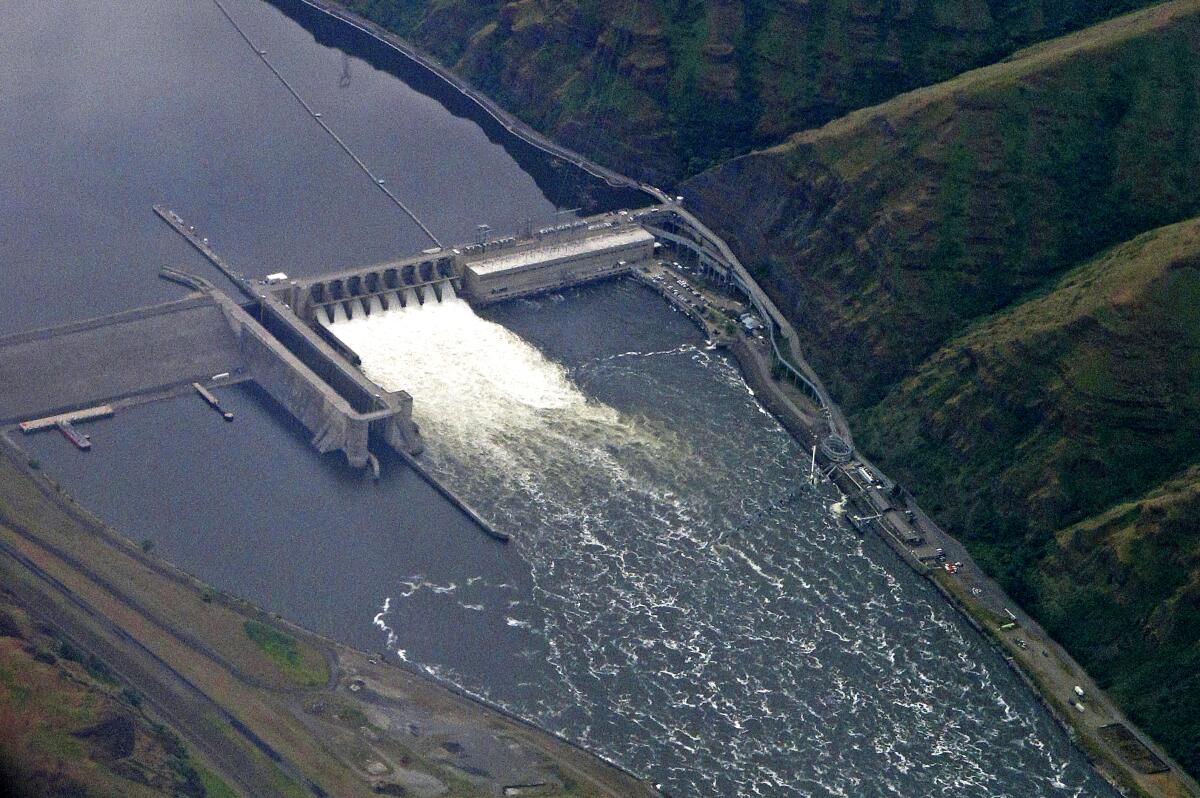Op-Ed: Listen up: A Republican says we have to breach four Snake River dams

- Share via
For a conservative Republican, U.S. Rep. Mike Simpson of Idaho did something extraordinary last month. By unveiling a proposal for a giant Pacific Northwest infrastructure overhaul that includes breaching four perennially disputed, fish-eradicating hydroelectric dams on the Snake River, he displayed the courage to accept an environmental reality that other conservatives have refused to face: These dams must go.
The four barriers are part of a 900-mile-long gauntlet, including eight major dams, that salmon and steelhead must run on their way from spawning grounds in Idaho, down the Snake River through Washington state and the Columbia River to the Pacific Ocean, then back again a few years later.
The Snake River basin once generated nearly half the salmon produced in the Columbia watershed, but the journey out and back to Idaho has proved so arduous that all of the river’s wild salmon runs are either threatened or endangered. Taking down the dams may not guarantee the fishes’ future, but if the dams remain, says Simpson, “the salmon and steelhead are on a certain path to extinction.”
In addition, as the cost of solar and wind energy has dropped — it’s now far below the cost of the hydropower — the dams have become a financial burden for the Bonneville Power Administration, the self-funding federal agency that markets the dam-generated electricity, along with power from other sources, throughout the region. Maintenance costs for the 50-year-old structures, plus the added cost of trying to mitigate their environmental impacts, are pushing the dams toward obsolescence.
Simpson’s plan is “absolutely great,” said Anthony Jones, an independent economist at Rocky Mountain Econometrics, “if for no other reason than that it puts the word ‘breach’ right out there in boldface capital letters, and everybody in the Northwest, no matter what their political persuasion, has to address that monster straight up.”
Given the enormous ramifications of dam demolition, Simpson’s proposal attempts to be as big as the Columbia watershed. It follows the sound environmental dictum that to be effective, environmental remedies must encompass whole ecosystems, in this case weighing multiple costs and benefits and mitigating the former with federal dollars.
Decommissioning the four dams would help reverse the headlong collapse of the region’s salmon populations, and by doing that, revitalize its fish-centric Native tribes. But the Columbia-Snake barge transport system, built to navigate reservoir lakes rather than a wild river, will immediately die. The Idaho and eastern Washington wheat farmers who still rely on barge shipments to the Pacific Coast would be deprived of a cheap transportation method; ports along the way would lose business, too.
Bonneville would lose a portion of its electricity capacity, but virtually all of it is unneeded. Since the emergence of solar and wind energy, the dams usually generate surplus electricity that is sold at a loss, mostly to California. Bonneville’s financial condition, currently dreadful, would be bolstered by the dams’ removal.
The many grants in Simpson’s plan include $3 billion for restoration of salmon habitat throughout the Columbia basin, in what could amount to the world’s largest river restoration effort. The farming industry would receive $1.5 billion to build rail terminals that will complete an already ongoing shift away from barge transportation. As for Bonneville, on five occasions it has ignored federal judges’ orders, in response to lawsuits related to the fishery, to consider decommissioning the dams. Now it could receive up to $10 billion, which would allow it to modernize parts of its infrastructure and replace the dams with more environmentally benign power sources.
The lure of such far-reaching federal largesse in Simpson’s plan could break down resistance to the dams’ demolition. Idaho’s GOP governor and other Republicans in the Boise statehouse and in Washington state quickly objected, but the plan has received support not just from the usual suspects — environmentalists, Democrats, tribes — but also entities that until now opposed dam breaching. Even Bonneville declined to denounce it, saying it “looks forward to more conversations about this concept.”
The $33.5-billion price tag sounds colossal, but considered in context, it’s reasonable. The failed efforts to buttress the Columbia watershed’s salmon population with hatcheries and fish-conveyance mechanisms — including fish barges, ladders and water-filled fish elevators — have cost almost $17 billion. If the dams remain and fish populations continue to dwindle, the cost of trying to maintain their numbers, as environmental law requires, will only soar, and the likely result still will be salmon extinction.
Despite the naysayers, Simpson’s ideas have a chance of making it into legislation that could pass. They coincide with a rare alignment of favorable factors. Democrats, who are generally open to the idea of dam demolition, control Congress, and Pacific Northwesterners have particular clout, especially on committees whose briefs include energy, infrastructure and commerce. The plan also fits snugly inside the multitrillion-dollar clean-energy-jobs-infrastructure energy stimulus bill that President Biden has promised later this year, and even in the closely divided Senate, there appears to be bipartisan support for reviving America’s public works.
Opening up the Snake River could be as transformative for the Pacific Northwest in the 21st century as dam building was nearly 100 years ago. The Columbia watershed hydroelectric projects brought electrification and economic vitality to the region.
But that New Deal era has to end for the Northwest to thrive now. Simpson’s plan, with its attention to fishery health, massive river restoration, environmentally sustainable energy, tribal justice and mitigation for the downsides of dam demolition, could deliver its urgently needed successor.
Jacques Leslie is a contributing writer to Opinion.
More to Read
A cure for the common opinion
Get thought-provoking perspectives with our weekly newsletter.
You may occasionally receive promotional content from the Los Angeles Times.










